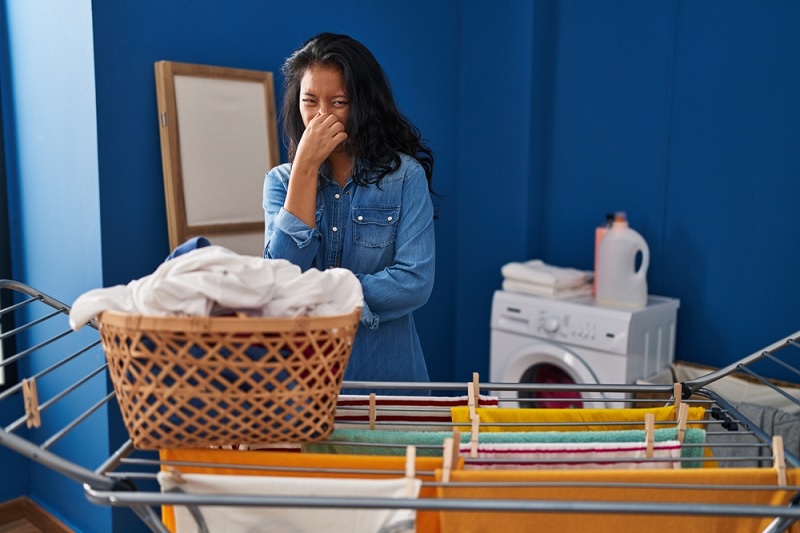Nobody likes damp smelling clothes. This issue can be especially annoying if you’ve just washed your clothes to make them smell better, and they’ve ended up smelling worse!
In this article, we’ll look at the most common causes of damp-smelling clothes, how to treat damp smells and how to stop your clothes smelling damp in the future.
Causes of Damp-Smelling Clothes (And Their Solutions)
Water itself generally doesn’t smell, so a ‘damp’ smell doesn’t mean that your clothes are wet. What actually causes a damp smell is mould, a type of fungi that thrives in damp environments.
Understanding this helps understand how to tackle damp-smelling clothes. Mould can grow on your clothes causing a damp or sour smell.
This can happen at all stages of the washing, drying and storage cycle. Here’s how your clothes end up smelling damp, and what to do about it.
1. Dirty washing machine
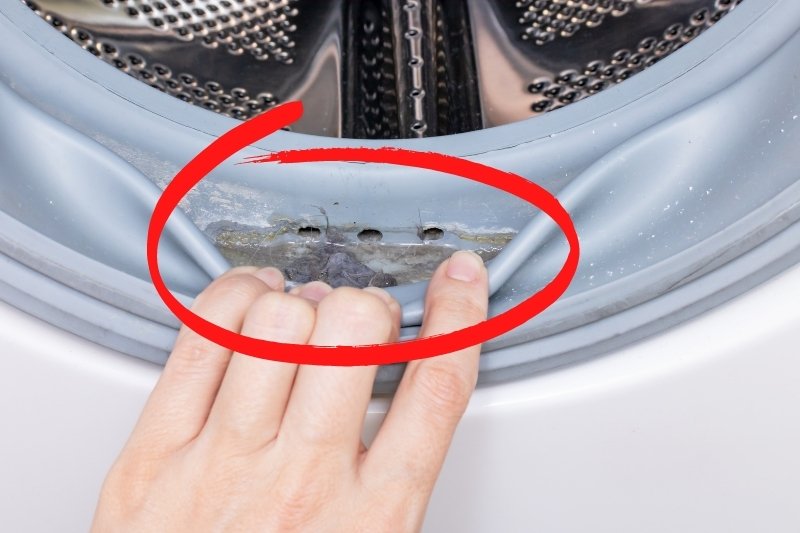
If your washing machine has developed mould and needs a clean, this unpleasant smell will transfer onto your clothes, making them smell worse after washing than they did before! You should clean your washing machine regularly to prevent this from happening.
Regularly clean your washing machine to prevent it from developing mould and bacteria which will transfer to your clothes, causing unpleasant smells.
Keep your washing machine door open slightly when you’re not using it. This will help dry it out and reduce the growth of mould.
You should also regularly clean anywhere else your clothes spend time, including your tumble dryer or drying rack, wardrobe, and so on.
2. Leaving wet clothes in the washing machine or laundry basket
If you leave clothes in the washing machine after the cycle has finished, they will eventually start to smell damp.
It’s ok to leave them for 10 minutes of so, but you should try to take them out as soon as possible and either put them in a well-ventilated place to dry, or put them in the tumble dryer.
Similarly, if you get caught in the rain or your clothes get drenched in sweat when exercising, you should try to wash them as soon as possible. If you leave wet clothes in the laundry basket for too long, mould will start to form, causing a damp smell.
3. Using the wrong quantity of laundry detergent

A common misconception is that the more detergent you put into your washing machine, the cleaner and therefore better-smelling your clothes will be. However, this isn’t always true.
It’s important to use the correct amount of laundry detergent (check the packaging of your detergent).
If you add more than the recommended amount the excess won’t rinse away but will remain in the fabric. This can cause mould growth on the clothes you’re trying to wash.
On the other hand, if you don’t use enough laundry detergent, the bacteria and dirt on your clothes won’t be removed as effectively, and your clothes will end up smelling unpleasant.
4. Always washing at low temperatures
If your clothes already have mould and mildew on them, washing at low temperatures of 30 or 40°C won’t kill the mould and prevent unpleasant smells from developing.
Sometimes it’s necessary to use hotter temperatures of 60°C or above, or use a laundry sanitiser product, but check the care label on your clothes first.
5. Slow or insufficient drying
If your clothes dry very slowly (for example if you’ve left them on the washing line for a couple of days in cold weather), it’s likely they will end up smelling damp as there is a lot of time for mould and mildew to form on them.
One solution to this is to use a tumble dryer, though tumble drying isn’t suitable for all clothes. You can also try drying clothes inside on a clothes airer, and use a dehumidifier to keep the humidity in the room low. This will speed up the drying process and reduce the risk of your clothes smelling damp.
6. Storing clothes in damp places with limited airflow
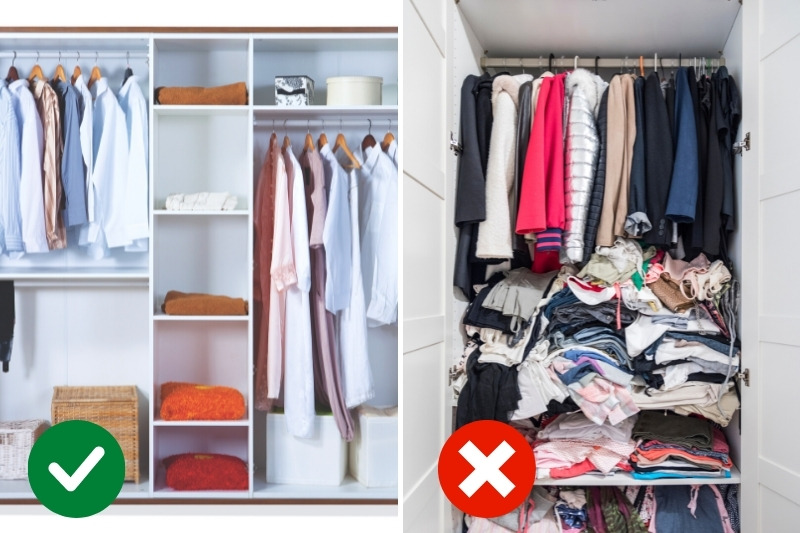
If your wardrobe or drawers are damp, this is likely to give your clothes a damp smell.
There are lots of easy ways to deal with a damp wardrobe, including lining the shelves with paper, using a dehumidifier and simply airing it out with the windows and doors open.
You should take all of the clothes out of your wardrobe or drawers and air them periodically, especially if you haven’t worn all of your clothes for a while. This will help prevent the development of a damp smell on them.

How to Remove a Damp Smell from Clothes
Here are a few ways to freshen up damp-smelling clothes.
Re-wash and re-dry
If you have the time, the best course of action is usually to re-wash and re-dry your clothes.
Make sure the washing machine is clean and odour-free, otherwise your clothes will just stay smelling damp.
For even better results, you could either soak your clothes in diluted white vinegar or sprinkle bicarbonate of soda (baking soda) over them and leave it for a few hours before shaking it off and putting your clothes in the washing machine.
You should also consider washing at a higher temperature than normal if your clothes’ care label says it’s ok to do so. Washing at 60°C will kill bacteria, but might damage some clothes, so be careful.
When you dry your clothes, try to make sure they dry as quickly as possible in a warm, well-ventilated place or a tumble dryer.
Air clothes in the sun
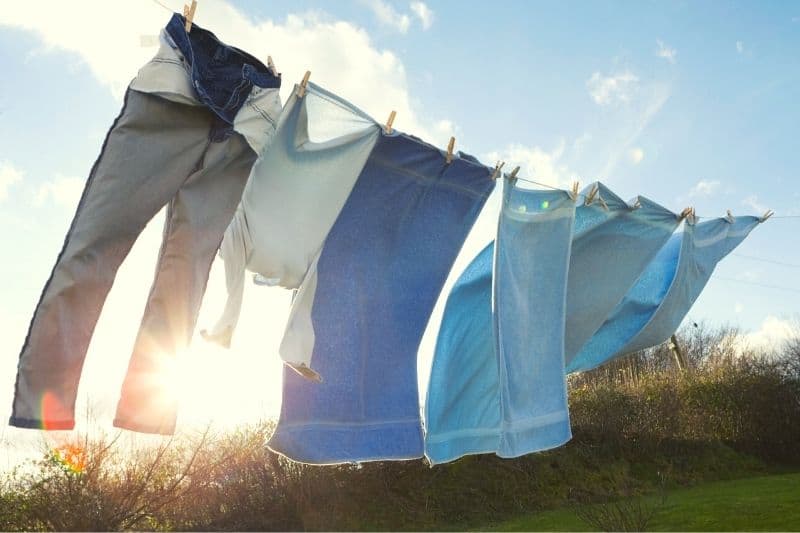
Airing clothes can be a good way to freshen them up. Sunlight can kill bacteria on the surface of clothes, so airing clothes in the sun can be a good way to remove odours.
Fabric freshener spray
Fabric freshener sprays are a convenient and quick solution if you don’t have time to re-wash your clothes.
Many of them not only hide the damp smell, but also have antibacterial properties which will tackle the cause of the damp smell.
How to Stop Clothes Smelling Damp in a Wardrobe

It’s common for wardrobes to end up smelling damp since they are dark places with limited airflow. Here are a few ways to tackle this issue.
Improve airflow
Proper ventilation helps prevent the build-up of mould and the damp smell that follows. Leave some space between the wardrobe and the wall/other furniture if you can, and make sure there is some space between your clothes inside the wardrobe itself.
Don’t overfill your wardrobe, as this will reduce airflow.
Reduce humidity
Try reducing the humidity inside your wardrobe using hanging wardrobe dehumidifiers like these from Nyxi. They contain moisture-absorbing crystals and will collect moisture into a leak-proof bag. They’re small, cheap and easy to use, and don’t need to be plugged in like a regular electric dehumidifier.
Make sure clothes are fully dry before putting them away
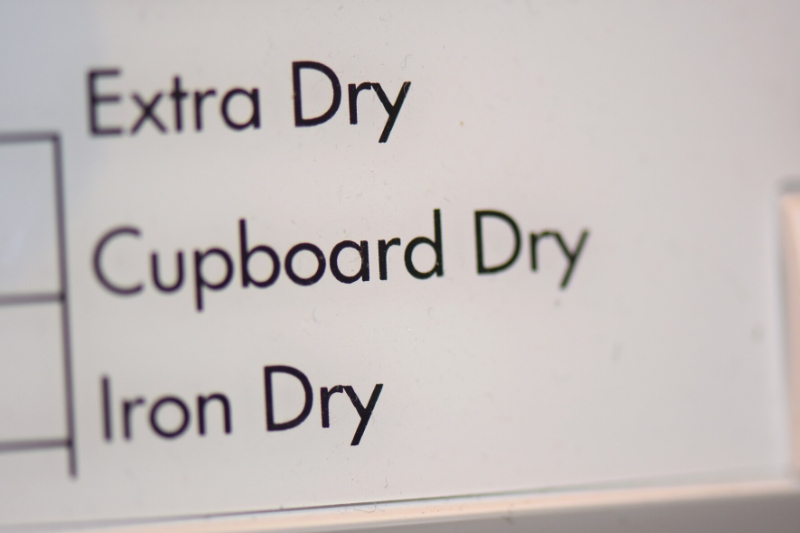
If your clothes aren’t fully dry when you put them in the wardrobe, they’re likely to develop a damp smell in the wardrobe.
Thoroughly air dry your clothes, or use the ‘Cupboard Dry’ or ‘Extra Dry’ (or equivalent) setting on your tumble dryer.
Clothes don’t always dry evenly, and some areas might still be damp after drying. It’s worth thoroughly checking clothes are dry all over before putting them away.
If some areas are still damp, try air-drying the garment, making sure these areas are exposed to plenty of airflow. Sometimes you will need to turn clothes inside out and leave them to dry for a bit longer.
Use natural odour absorbers and wardrobe fresheners
Consider putting some scented sachets in your wardrobe to absorb odours and freshen up your clothes. You can get hanging sachets in a range of scents including cedar, lavender, jasmine and rose.
Regularly air your clothes
Regularly airing out your clothes is crucial for preventing dampness and musty odours.
Take advantage of warm, sunny and dry weather to air out your wardrobe and hang your clothes outside (or inside near a window) in the fresh air and sunlight.
This will help dry out your clothes and the wardrobe, preventing mildewy smells from forming.
Regularly clean your wardrobe
Regularly empty your wardrobe and give it a good dust/vacuum and clean. This will stop the growth of mould and bacteria, which will end up leaving your clothes smelling damp if not tackled.
Use airtight storage for seasonal clothes
When storing seasonal clothing for example putting your summer clothes away for the winter, make sure they are clean and dry before packing them away well.
You could use vacuum-sealed bags or airtight containers to protect them from moisture and pests. You can also put moisture-absorbing products like silica gel packets in the storage containers to help protect them even more from damp.

In The Wash is your guide to the best laundry and cleaning products, tips and tricks. Our mission is to solve the UK’s cleaning and laundry dilemmas!
